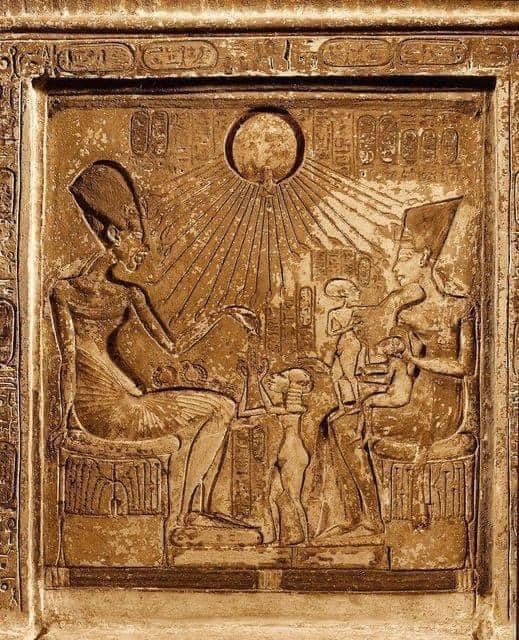Nefertiti, the great royal wife of Amenhotep IV (later known as Akhenaten), stands as one of the most iconic and enigmatic figures in ancient Egyptian history. Known for her extraordinary beauty and commanding presence, she has captivated scholars and the general public for centuries. However, Nefertiti was much more than a symbol of beauty; she was a powerful and influential woman who played a critical role in the significant religious and political transformations during her husband’s reign.
Nefertiti: More Than Just a Pretty Face

This article explores the life and legacy of Nefertiti, examining her role as a co-regent, her influence during the Amarna period’s religious and artistic revolution, and the enduring mystery surrounding her ultimate fate. Through historical accounts and archaeological evidence, we aim to shed light on the depth and significance of Nefertiti’s remarkable story.
The Rise of Nefertiti
The origins of Nefertiti remain obscure, though it is believed she was born around 1370 BCE into a prominent family with close ties to the royal court. Her father, Ay, served as a high-ranking official and advisor to the pharaoh, while her mother, Tey, held the distinguished title of “Wet Nurse of the King’s Great Wife.” This esteemed lineage likely contributed to Nefertiti’s ascension to prominence.
In her late teens or early twenties, Nefertiti married Amenhotep IV, the ambitious son of Pharaoh Amenhotep III. At the time of their marriage, Amenhotep IV was the crown prince. He would soon ascend the throne and initiate a radical transformation of Egyptian society.
The Amarna Revolution
Amenhotep IV’s reign heralded significant shifts in Egypt’s religious and political landscape. Upon taking the throne, he changed his name to Akhenaten and spearheaded a sweeping religious reform known as the Amarna Revolution.
The centerpiece of Akhenaten’s new vision was the worship of a single deity, the Aten, represented by the solar disk. He sought to replace the traditional polytheistic system with a monotheistic religion centered on the Aten. This profound shift in religious ideology was accompanied by relocating the capital from Thebes to a newly constructed city named Akhetaten, or “Horizon of the Aten,” which served as the focal point for Aten worship.
Nefertiti played a vital role in this transformative period. As Akhenaten’s Great Royal Wife, she was not merely a consort but also a co-regent and influential figure. Her importance is evident in the artistic depictions of the royal couple, where she is frequently portrayed alongside Akhenaten, often participating in religious rituals traditionally reserved for the pharaoh.
The Artistic Revolution of the Amarna Period
The Amarna period was characterized by extraordinary artistic innovation and experimentation. Akhenaten’s religious reforms were reflected in the art and architecture of the time, which diverged significantly from traditional Egyptian styles. The depictions of the royal family, including Nefertiti, emphasized a naturalistic and expressive approach, showcasing the human form and emotional connections.
One of the most renowned examples of Amarna art is the bust of Nefertiti, discovered in 1912 by German archaeologist Ludwig Borchardt. This exquisite sculpture, now housed in the Neues Museum in Berlin, epitomizes Nefertiti’s beauty and the artistic achievements of her era.
The Mystery of Nefertiti’s Fate
Despite the wealth of artistic and historical evidence about Nefertiti’s life, her ultimate fate remains one of history’s great mysteries. Following Akhenaten’s death, his successors, including Tutankhamun, sought to erase the memory of the Amarna period and the Aten’s monotheistic worship. Many artworks and monuments depicting Nefertiti and her family were defaced or destroyed, complicating efforts to reconstruct her story.
Several theories attempt to explain Nefertiti’s disappearance from historical records. Some scholars speculate that she briefly ruled as pharaoh, possibly under the names Neferneferuaten or Smenkhkare, before her death or disappearance. Others propose that she may have been exiled or executed by Akhenaten’s successors, who aimed to dismantle all remnants of the Amarna revolution.
Despite the uncertainty surrounding her fate, Nefertiti’s legacy endures as a symbol of power and influence. Her role in the religious and political upheaval of the Amarna period and the mystery of her disappearance continue to fascinate scholars and enthusiasts alike.
Conclusion
Nefertiti was far more than a symbol of beauty; she was a woman of immense power and influence who shaped one of ancient Egypt’s most transformative eras. Through her artistic representations, her co-regency with Akhenaten, and the enduring enigma of her fate, Nefertiti remains an iconic figure in history. Her story offers a testament to the achievements and lasting legacy of ancient Egyptian civilization.
As new evidence and insights about Nefertiti’s life and times come to light, her story continues to inspire and captivate. By exploring her life and legacy, we gain a deeper appreciation of the complex history of one of ancient Egypt’s most remarkable and influential figures.





